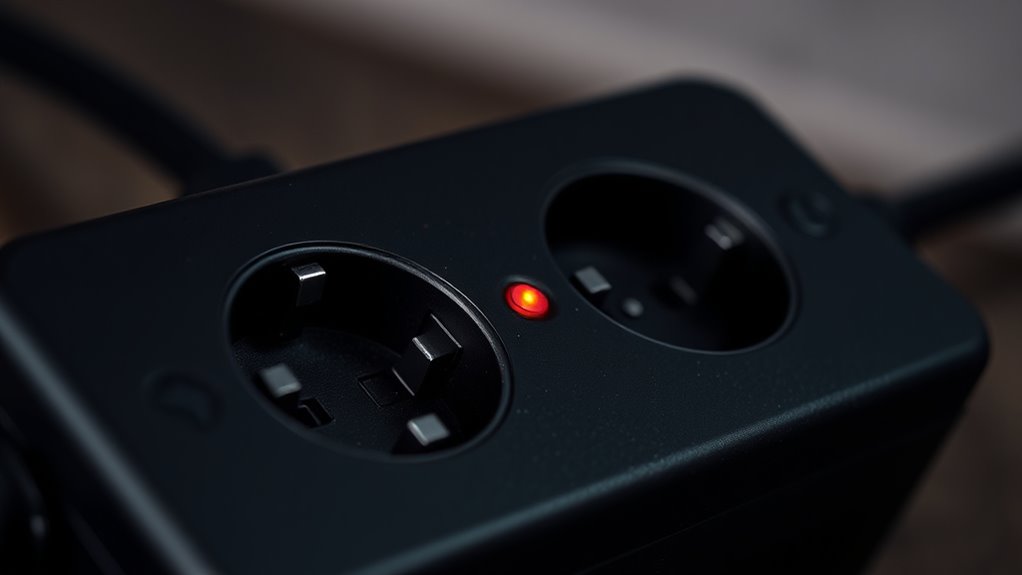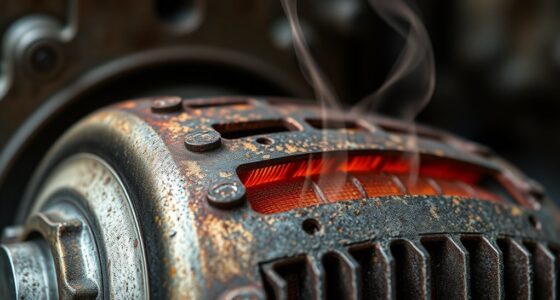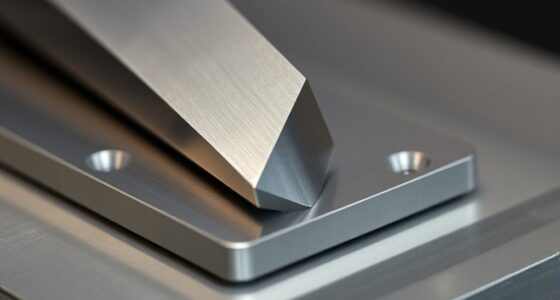To prevent your electric splitter’s breaker from tripping, first avoid overloading circuits by spreading out high-power tools across different outlets. Always verify your extension cords are rated for the device’s current and inspect cords and outlets regularly for damage or wear. Consider installing dedicated circuits for heavy equipment if needed. Properly ventilate your work area and avoid using damaged cords. Keep an eye on these safety tips to help maintain a stable electrical setup and reduce trips—more details ahead.
Key Takeaways
- Distribute power load by connecting devices to different outlets to avoid overloading the circuit.
- Use extension cords rated for high current and ensure they are not too long or damaged.
- Regularly inspect cords, outlets, and connections for signs of wear, damage, or overheating.
- Install dedicated circuits for high-power tools or splitters to prevent repeatedly tripping breakers.
- Consult a licensed electrician to assess your wiring system and upgrade circuits if frequent trips occur.

Ever wondered why your electric splitter suddenly stops working? One common reason is a tripped breaker, often caused by a circuit overload. When you connect your splitter and other power tools or devices to the same circuit, you’re increasing the risk of overloading it. A circuit overload happens when the total current drawn exceeds the circuit’s capacity, causing the breaker to trip as a safety precaution. This automatic shutdown protects the wiring from overheating and prevents potential fires. To prevent this from happening, you need to understand your circuit’s limits and avoid pushing them beyond their capacity.
Start by checking the amperage rating of your circuit and the power requirements of your electric splitter. Most splitters operate on standard household circuits, typically rated at 15 or 20 amps. If you’re plugging in multiple devices or using extension cords, be mindful of their combined load. Overloading occurs when the sum of all devices exceeds the circuit’s capacity, triggering the breaker. To reduce this risk, always plug high-power tools into circuits dedicated to heavy loads, or distribute your devices across different outlets. Don’t forget to inspect your extension cords; using cords that are too long or not rated for high current can also lead to overloads.
Practicing safety precautions is essential when working with electrical equipment. Before starting work, always turn off the breaker before plugging or unplugging your electric splitter. This minimizes the risk of electrical shocks and prevents accidental overloads. Furthermore, avoid using damaged cords or outlets, as they can cause short circuits or sparks that trip your breaker unexpectedly. Keep your work area clear of clutter and ensure good ventilation to prevent overheating of cords and equipment.
Regularly inspecting your electrical setup can help you catch potential issues before they cause a breaker to trip. Check for signs of wear, frayed wires, or loose connections. If your breaker trips repeatedly, it might be time to consult a professional electrician. They can assess your wiring and recommend upgrades if your circuits are frequently overloaded. You should also consider installing dedicated circuits for your heavy-duty tools, including your electric splitter, to prevent overloads and improve safety. Additionally, understanding the role of circuit capacity in preventing overloads can help you make informed decisions about your electrical setup.
Frequently Asked Questions
Can a Tripped Breaker Cause Damage to the Splitter?
A tripped breaker can cause damage to the splitter if it repeatedly trips or is overlooked, leading to potential electrical issues. While a single trip usually protects the splitter from damage, frequent trips might indicate underlying problems that could compromise splitter safety. To prevent damage, always address the cause of breaker trips promptly and ensure proper wiring. Regular inspections help maintain both breaker integrity and overall splitter safety.
How Often Should I Check My Electrical Splitter for Issues?
Imagine your splitter as your trusty sidekick, like Robin to Batman’s Gotham. You should check it monthly for warning signs like flickering, unusual noises, or overheating. Stick to a regular maintenance schedule to catch issues early. If you notice any irregularities, avoid using the splitter until you’ve inspected or repaired it. Consistent checks help prevent tripped breakers and ensure your equipment stays safe and reliable, just like a well-oiled machine.
Is It Safe to Reset a Breaker Immediately After It Trips?
It’s generally safe to reset a breaker immediately after it trips, but you should first follow safety precautions. Turn off connected devices and inspect for any obvious issues. When performing a breaker reset, make sure your hands are dry and stand on a dry surface. If the breaker trips again quickly, avoid resetting it and consult an electrician. Always prioritize safety to prevent electrical hazards.
What Tools Are Recommended for Troubleshooting Breaker Trips?
Imagine a superhero toolkit, but for electricians—your recommended tools include a multimeter for testing voltage and continuity, and a circuit diagram to map connections. These tools help you troubleshoot breaker trips effectively. Use the multimeter to check for faults, and the circuit diagram to identify potential overloads or short circuits. With these, you’ll be armed to diagnose issues quickly, avoiding guesswork and keeping your electrical system safe.
Are There Specific Surge Protectors for Electric Splitters?
Yes, there are specific surge protector types designed for electric splitters that enhance splitter safety. Look for surge protectors with high joule ratings and appropriate cord lengths to prevent overloads. These protectors help guard against power surges that can trip breakers or damage the equipment. Always choose a surge protector suited for your splitter’s power needs, and verify it’s certified for safety to maintain peak operation and prevent electrical issues.
Conclusion
To prevent future trips, regularly check your splitter and cords, keep your workspace clear and organized, and avoid overloading the circuit. Stay attentive to signs of wear or overheating, and don’t ignore small issues before they become big problems. By staying cautious, staying mindful, and staying proactive, you protect your equipment, prevent outages, and ensure safety. In the end, prevention is your best tool—keep your splitter running smoothly, keep your work safe, and keep your confidence high.









